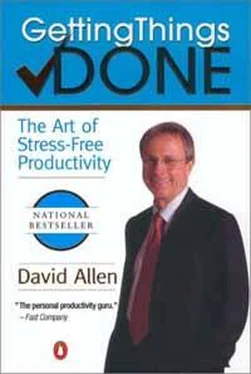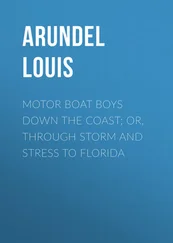This is where you need to access your intuition and begin to rely on your judgment call in the moment. To explore that concept further, let's examine two more models for deciding what's "most important" for you to be doing.
2. The Three fold Model for Evaluating Daily Work
When you're getting things done, or "working" in the universal sense, there are three different kinds of activities you can been gaged in:
• Doing predefined work
• Doing work as it shows up
• Defining your work
Doing Predefined Work When you're doing predefined work, you're working off your "Next Actions" lists—completing tasks that you have previously determined need to be done, managing your workflow. You're making the calls you need to make, drafting ideas you want to brainstorm, or preparing a list of things to talk to your attorney about.
Doing Work as It Shows Up Often things come up ad hoc— unsuspected, unforeseen—that you either have to or choose to respond to as they occur. For example, your partner walks into your office and wants to have a conversation about the new product launch, so you talk to her instead of doing all the other things you could be doing. Every day brings surprises—unplanned-for things that just show up, and you'll need to expend at least some time and energy on many of them. When you follow these leads, you're deciding by default that these things are more important than anything else you have to do.
Defining Your Work Defining your work entails clearing up your in-basket, your e-mail, your voice-mail, and your meeting notes and breaking down new projects into actionable steps. As you process your inputs, you'll no doubt be taking care of some less-than-two-minute actions and tossing and filing numerous things (another version of doing work as it shows up). A good portion of this activity will consist of identifying things that need to get done sometime, but not right away. You'll be adding to all of your lists as you go along.
Once you have defined all your work, you can trust that your lists of things to do are complete. And your context, time, and energy available still allow you the option of more than one thing to do. The final thing to consider is the nature of your work, and its goals and standards.
3. The Six-Level Model for Reviewing Your Own Work
Priorities should drive your choices, but most models for deter-mining them are not reliable tools for much of our real work activity. In order to know what your priorities are, you have to know what your work is. And there are at least six different perspectives from which to define that. To use an aerospace analogy,the conversation has a lot to do with the altitude.
• 50,000+ feet: Life
• 40,000 feet: Three-to five-year vision
• 30,000 feet: One-to two-year goals
• 20,000 feet: Areas of responsibility
• 10,000 feet: Current projects
• Runway: Current actions
Let's start from the bottom up:
Runway: Current Actions This is the accumulated list of all the actions you need to take—all the phone calls you have to make, the e-mails you have to respond to, the errands you've got to run, and the agendas you want to communicate to your boss and your spouse. You'd probably have three hundred to five hundred hours' worth of these things to do if you stopped the world right now and got no more input from yourself or anyone else.
10,000 Feet: Current Projects Creating many of the actions that you currently have in front of you are the thirty to one hundred projects on your plate. These are the relatively short-term out-comes you want to achieve, such as setting up a home computer, organizing a sales conference, moving to a new headquarters, and getting a dentist.
20,000 Feet: Areas of Responsibility You create or accept most of your projects because of your responsibilities, which for most people can be defined in ten to fifteen categories. These are the key areas within which you want to achieve results and maintain standards. Your job may entail at least implicit commitments for things like strategic planning, administrative support, staff development, market research, customer service, or asset management. And your personal life has an equal number of such focus arenas: health, family, finances, home environment, spirituality, recreation, etc. Listing and reviewing these responsibilities gives a more comprehensive framework for evaluating your inventory of projects.
30,000 Feet: One-to Two-Year Goals What you want to be experiencing in the various areas of your life and work one to two years from now will add another dimension to defining your work. Often meeting the goals and objectives of your job will require a shift in emphasis of your job focus, with new areas of responsibility emerging. At this horizon personally, too, there probably are things you'd like to accomplish or have in place, which could add importance to certain aspects of your life and diminish others.
40,000 Feet: Three-to Five-Year Vision Projecting three to five years into the future generates thinking about bigger categories: organization strategies, environmental trends, career and life-transition circumstances. Internal factors include longer-term career, family, and financial goals and considerations. Outer-world issues could involve changes affecting your job and organization, such as technology, globalization, market trends, and competition. Decisions at this altitude could easily change what your work might look like on many levels.
50, 000+ Feet Life This is the "big picture" view. Why does your company exist? Why do you exist? The primary purpose for any-thing provides the core definition of what its "work" really is. It is the ultimate job description. All the goals, visions, objectives, projects, and actions derive from this, and lead toward it.
These altitude analogies are somewhat arbitrary, and in real life the important conversations you will have about your focus and your priorities may not fit exactly to one horizon or another. They can provide a useful framework, however, to remind you of the multilayered nature of your "job" and resulting commitments and tasks.
Obviously, many factors must be considered before you feel comfortable that you have made the best decision about what to do and when. "Setting priorities" in the traditional sense of focus ing on your long-term goals and values, though obviously a necessary core focus, does not provide a practical framework for a vast majority of the decisions and tasks you must engage in day to day. Mastering the flow of your work at all the levels you experience that work provides a much more holistic way to get things done, and feel good about it.
Part 2 of this book will provide specific coaching about how to use these three models for making action choices, and how the best practices for collecting, processing, planning, organizing, and reviewing all contribute to your greatest success with them.
3. Getting Projects Creatively Under Way: The Five Phases of Project Planning
THE KEY INGREDIENTS of relaxed control are (1) clearly defined outcomes (projects) and the next actions required to move them toward closure, and (2) reminders placed in a trusted system that is reviewed regularly. This is what I call horizontal focus. Al though it may seem simple, the actual application of the process can create profound results.
You've got to think about the big things while you're doing small things, so that all the small things go in the right direction.
— Alvin Toffler
Enhancing "Vertical" Focus
Horizontal focus is all you'll need in most situations, most of the time. Sometimes, however, you may need greater rigor and focus to get a project under control, to identify a solution, or to ensure that all the right steps have been deter mined. This is where vertical focus comes in. Knowing how to think productively in this more "vertical" way and how to integrate the results into your personal system is the second powerful behavior set needed for knowledge work.
Читать дальше











